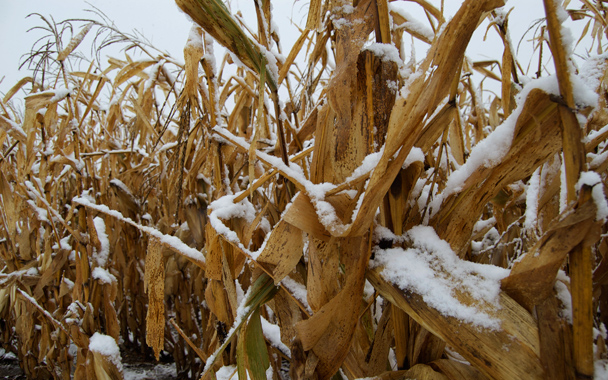Blizzard! The first of the season swept into South Dakota Wednesday night and by Thursday afternoon, farm country was paralyzed. Travel on Interstate 90 was prohibited. The corn harvest was stopped in its tracks. This is the kind of wet, fat-flaked, early-winter blizzard that blows so hard the snow sticks and turns to concrete on kitchen window panes. The sun comes up, but you can’t see anything. These are days when fidgety farmers are forced to sit and drink coffee and think about falling commodity prices. Corn for December delivery was as high as $7.80 in June. Today it is $3.75.
In anticipation of the storm, Charlie Johnson harvested corn until 3:30 in the morning on Wednesday. His organic corn is already contracted at $8.80 a bushel to an organic poultry company in Iowa. When he made the deal last spring it was a good, solid organic premium. Now it looks like a bonanza. Last week, Johnson was down in the dumps because his soybean yields were so low. This week he’s surprised ... pleasantly surprised. “We may fill our bins with corn rather than soybeans,” he says. “Maybe the corn will keep us in business one more year.” His crop is wet. His drying bins are full. And with the blizzard bearing down on him, Johnson still has 100 acres of corn standing in the field.
Dale Hargens got up on Tuesday, voted at 7 A.M., took the corn head off his combine, replaced it with the sunflower head, and drove the combine through his sunflower fields until 10 o’clock at night. Sitting around waiting to get back to work is doubly hard on Hargens this week. He lost his bid for the South Dakota state Senate. From Democratic Majority Leader in the South Dakota House of Representatives to a small-town farmer in one day ... tough to swallow. He lost by 191 votes. “If the harvest hadn’t been so bad—so much stop-and-go because of rain—maybe it would have made a difference,” he offers. “I didn’t spend near enough time campaigning in Huron [the biggest town in his district, 45 miles away]. But farming comes first.” He says he doesn’t mind losing. He doesn’t sound convincing.
Hargens’s yields are high, just like he expected back in June. His worst fields are 145 bushels an acre. His best fields are 170. Both he and Johnson agree that the key to the next week is whether snow builds up on the cornstalks. “You can combine corn until four in the morning in a wet, muddy field,” Johnson says. “But you can’t combine in the rain. And you can’t pick corn when it still has snow on it. The snow compacts and freezes in the combine and breaks things.”
Jim Lutter isn’t even trying to harvest his corn. He doesn’t have a large storage capacity, so why even start combining wet corn? “Why would anyone store corn if they can sell it for four dollars?” he told me in June. Now, Lutter must work around his limits. He will spend the blizzard in his airplane hangar, winterizing the building and servicing his spray plane. He offers a quick side note: “I still had some spraying to do in late October, but my clients cancelled on me. The farmers around here are out of money.”
Near Aberdeen, Scott Christenson’s harvest finally hit its stride in the week before the blizzard. “We’re picking the best corn we’ve ever raised. Our best fields are over one seventy-five. Our average is one sixty-five.” The Christensons have their own propane drying bins. The corn comes out of the field, is dried on the farm, and then is trucked directly to the nearby ethanol plant. The Christensons have invested heavily over the years in storage and drying capacity. Now it’s paying off.
Last summer Scott and his brother took a gamble. “When the price was high, we contracted a lot of our crop, about eleven hundred acres. Some was at four dollars and some was as much as six dollars and eighty cents.” Scott credits his banker with encouraging him to go ahead and contract when prices were high, even though he ran the risk that his yields might come in below his contract goals. Storage capacity is the key to the gamble. In the old days, a farmer might contract 1,000 bushels for delivery months in advance, before he knew what his yields would be. If the harvest failed, or came in short, say 800 bushels, the farmer was still on the line for the contract. He often had to buy the missing 200 bushels on the open market to meet his contract. If, by chance, prices had risen over the season, a farmer could be wiped out buying expensive corn in November to meet a contract he agreed to in June. By having a fluid supply of stored corn, farmers like Scott Christenson can manage the flow of their crop from harvest to buyer and hedge their bets.
Charlie Johnson has skinned the cat another way. Because organic harvests are so fragile and unpredictable, his contracts have “act of God” clauses that compel his buyers to purchase whatever he produces rather than setting specific targets for the harvest.
Jim Lutter is stuck without adequate storage or organic premiums. Nervous about taking risks with long-term contracts, farmers like Lutter harvest the crops in the fall and either use the corn on the farm to feed cattle, or sell it to the local elevator at whatever price they can get.
This is the kind of stuff farmers think about, sipping coffee, waiting for a blizzard to pass.


